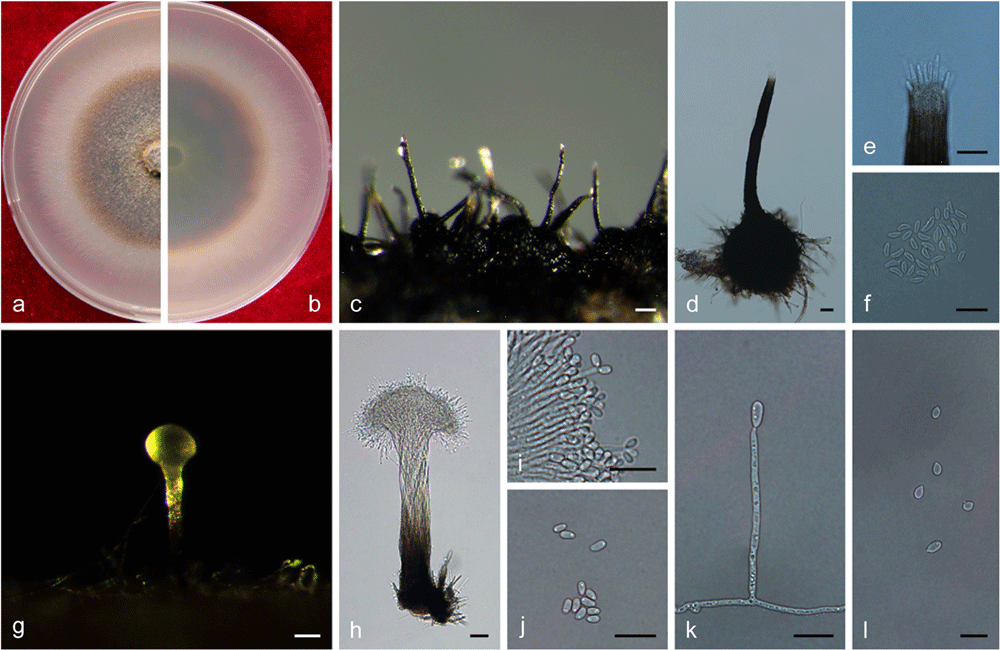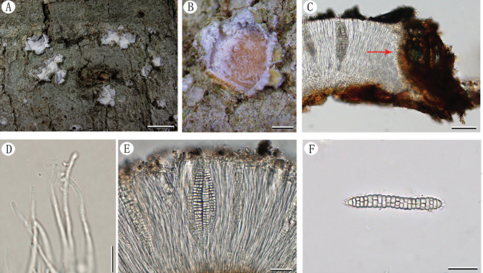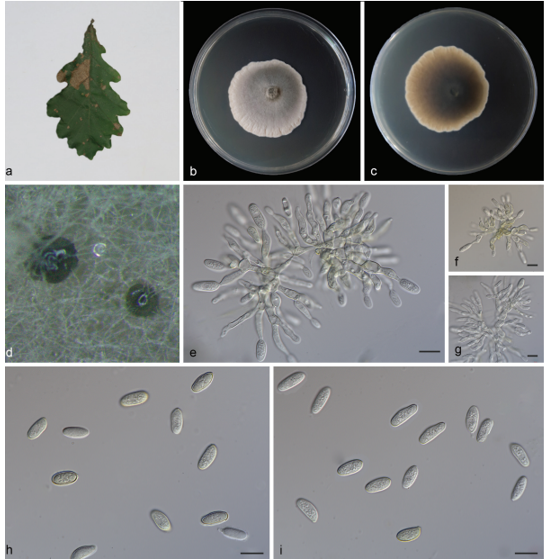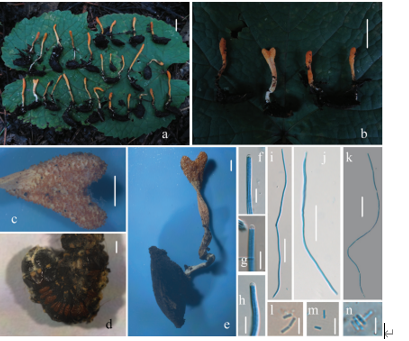Ophiostoma genhense Z. Wang & Q. Lu 2020
MycoBank MB 830610
Holotype: China, Inner Mongolia Autonomous Region: Genhe, from Ips subelongatus infesting Larix gmelinii, Sept. 2017, Q. Lu (CXY 2001 – holotype; CFCC 52675 – ex-type culture).
Morphological description
Sexual morph perithecial. Perithecia few on 2% MEA after 20 d, developing on a superficial mycelium or partly embedded in the agar, bases black, (103–) 114–156 (− 164) μm diam., with some basal hyphal ornamentation, dark brown to black; necks black, cylindrical, straight or slightly curved, (135–) 210–347 (− 400) μm long, (17–) 21.5–32.5 (− 38) μm wide at the base down to (8.5–) 12.5–17 (− 18.5) μm wide at the apex, composed of parallel, septate, laterally fused hyphae, ending in a crown of hyaline. Ostiolar hyphae occasionally present, 6.5–13 (− 18) μm long. Ascospores hyaline, allantoid or crescent in side view, without sheath, aseptate, (3.5–) 4–5 (− 6) × (1.5–) 2 (− 2.5) μm. Asexual morphs: pesotum-like and hyalorhinocladiellalike. Pesotum-like morph: synnemata solitary or in groups, the base black, (22.5–) 24.5–45.5 (− 48.5) μm wide, (170–) 184–257 (− 271) μm tall, including the conidiogenous apparatus. Conidiogenous cells (12–) 15–23 (− 26.5) × 1.5–2 μm. Conidia hyaline, smooth, cylindrical, aseptate, (3–) 3.5–4 (− 4.5) × 2–2.5 μm. Hyalorhinocladiella- like morph: conidiogenous cells arising directly from the hyphae, (25–) 30.5–43 (− 44) × 1.5–2 μm. Conidia hyaline, smooth, ovate to cylindrical, aseptate, (3.5–) 4–5.5 (− 7) × (2.5–) 3–3.5 (− 4) μm. Cultures: Colonies on 2% MEA at 25 °C reaching 80mm diam. in 10 d, initially hyaline, later becoming brown, mycelium superficial or sparsely aerial, the colonies edge thinning radially, synnemata and perithecia scattered in the centre. Optimal temperature for growth at 25 °C, no growth observed at 5 °C and 35 °C.
Habitat: L. gmelinii pure plantation.
Ecology: Isolated from Ips subelongatus infesting dying Larix gmelinii and stock log.
Distribution: Inner Mongolia Autonomous Region, China.
GenBank Accession: ITS/LSU MK748199; β-tubulin gene MN896026; EF-1α MN896074; calmodulin gene MN896102
Notes: Ophiostoma genhense and O. multisynnematum formed two distinct, well-supported clades within the O. piceae complex, in which they were closely related to O. breviusculum (Chung et al. 2006). They can be both differentiated from O. breviusculum by the presence of a hyalorhinocladiella-like asexual state, which is absent in the latter.
Reference: Wang Z, Liu Y, Wang HM et al. (2020) Ophiostomatoid fungi associated with Ips subelongatus, including eight new species from northeastern China

Ophiostoma hongxingense. Morphological characteristics of Ophiostoma hongxingense. (CFCC 52695). a–b. Five-day-old cultures on 2% MEA; c–e. Hyalorhinocladiella-like asexual morph: conidiogenous cells and conidia. Scale bars: c–e = 10 μm









